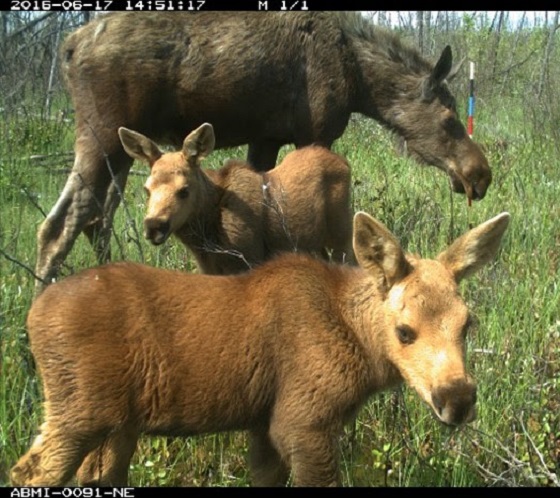Alberta
Alberta wildlife is ready for its close-up

Two moose calves in Wood Buffalo National Park. Photo credit: Alberta Biodiversity Monitoring Institute (ABMI).
Researchers are using remote cameras and cutting-edge tools to better study and monitor Alberta’s wildlife.
Researchers have used remote cameras to monitor wildlife in Alberta for many years, and for good reason: the technology is cost-effective, efficient and safe while enabling researchers to observe multiple species at the same time. However, collecting the data, coordinating with other researchers and reporting information effectively can be challenging.
Alberta’s government is teaming up with researchers to develop new resources and tools that will help wildlife experts work together, study and monitor bears, moose, cougars and other species from miles away.
“We are dedicated to wildlife conservation in Alberta. Led by our Chief Scientist, we are helping researchers better understand how wildlife is behaving and responding to the world around them to help make sure that Alberta’s amazing wildlife continue to grow and thrive for future generations.”
Remote cameras, also referred to as wildlife cameras or camera traps, are important tools for wildlife conservation. Their footage allows researchers to gain a better understanding of wildlife numbers, behaviours and ways to support conservation, all while keeping humans at a safe distance from the action.
The use of remote cameras by Alberta researchers, agencies, industry and the public has been steadily increasing. Alberta’s government and the Alberta Biodiversity Monitoring Institute (ABMI) have helped distribute remote cameras to every corner of the province, from the boreal forest in the north to the grasslands in the south, tracking more than 2,500 species.
Through a $66,000 grant by the Office of the Chief Scientist in 2022, Alberta Environment and Protected Areas, ABMI and the University of Alberta developed new remote camera standards and best practice resources, as well as training materials and tools for wildlife monitoring. As part of this project, Alberta released new remote camera survey guidelines and standards to help improve research, data collection and reporting. This work also improved Alberta’s understanding of what remote cameras are capturing, leading researchers to adjust the cameras and get a clearer picture of wildlife conditions.
This year, another $70,000 in government funding will go towards creating a new online tool to help researchers design remote camera projects, gather data and analyze it. With remote cameras placed throughout the province, this new online tool will help Alberta’s wildlife monitoring projects streamline and coordinate their efforts, regardless of their location, leading to better research.
“The Office of the Chief Scientist is proud to support research and guidance on use of cutting-edge technology to help improve monitoring of provincial wildlife populations. This work will produce results to support the management and conservation of mammals and other wildlife species in the province.”
“Alberta collects a vast amount of data using remote wildlife cameras. The funds provided by the chief scientist’s office will help us develop analysis frameworks that make the work done by individual organizations more consistent, repeatable and transparent. It also will help us better approaches for sharing data that drastically improve our ability to measure and manage at broad scales the species and ecosystems that we treasure.”
“The implications for data compatibility are huge: the more the standards are adopted by remote camera users, the larger the pool of data available to answer bigger and broader questions about wildlife. The Alberta remote camera steering committee is now working to develop accessible tools to support all users, from new to experienced users, in designing remote camera projects, data analysis and modelling. This will help more people conduct effective wildlife camera research and monitoring while also increasing the amount of data available to all.”
Quick facts
- The Office of the Chief Scientist coordinates the delivery of an environmental science program to provide scientifically rigorous data, information and reporting on the condition of Alberta’s environment.
- Grants through the Office of the Chief Scientist support evidence-informed decisions on programs and policies addressing Alberta’s natural resources.
- Remote cameras are most often used to monitor medium to larger mammals like white-tailed deer and bears but can also capture images of smaller creatures like birds and amphibians. They are also used to monitor elusive and far-ranging predators like wolverines and cougars.
- Typically, the camouflaged camera is mounted to a tree or post. Some are programmed to trigger when movement or a change in heat is detected in their field of view, while others are activated by a timer. The camera collects data on all species that pass by and stamps the video or picture with the date and time.
- The chief scientist and the Alberta government are committed to supporting research and delivering accessible reporting on the condition of Alberta’s environment.
Related information
- Remote Camera Survey Guidelines and Alberta Metadata Standards
- Wildlife Cameras for Adaptive Management
Multimedia
Alberta
Alberta’s grand bargain with Canada includes a new pipeline to Prince Rupert

From Resource Now
Alberta renews call for West Coast oil pipeline amid shifting federal, geopolitical dynamics.
Just six months ago, talk of resurrecting some version of the Northern Gateway pipeline would have been unthinkable. But with the election of Donald Trump in the U.S. and Mark Carney in Canada, it’s now thinkable.
In fact, Alberta Premier Danielle Smith seems to be making Northern Gateway 2.0 a top priority and a condition for Alberta staying within the Canadian confederation and supporting Mark Carney’s vision of making Canada an Energy superpower. Thanks to Donald Trump threatening Canadian sovereignty and its economy, there has been a noticeable zeitgeist shift in Canada. There is growing support for the idea of leveraging Canada’s natural resources and diversifying export markets to make it less vulnerable to an unpredictable southern neighbour.
“I think the world has changed dramatically since Donald Trump got elected in November,” Smith said at a keynote address Wednesday at the Global Energy Show Canada in Calgary. “I think that’s changed the national conversation.” Smith said she has been encouraged by the tack Carney has taken since being elected Prime Minister, and hopes to see real action from Ottawa in the coming months to address what Smith said is serious encumbrances to Alberta’s oil sector, including Bill C-69, an oil and gas emissions cap and a West Coast tanker oil ban. “I’m going to give him some time to work with us and I’m going to be optimistic,” Smith said. Removing the West Coast moratorium on oil tankers would be the first step needed to building a new oil pipeline line from Alberta to Prince Rupert. “We cannot build a pipeline to the west coast if there is a tanker ban,” Smith said. The next step would be getting First Nations on board. “Indigenous peoples have been shut out of the energy economy for generations, and we are now putting them at the heart of it,” Smith said.
Alberta currently produces about 4.3 million barrels of oil per day. Had the Northern Gateway, Keystone XL and Energy East pipelines been built, Alberta could now be producing and exporting an additional 2.5 million barrels of oil per day. The original Northern Gateway Pipeline — killed outright by the Justin Trudeau government — would have terminated in Kitimat. Smith is now talking about a pipeline that would terminate in Prince Rupert. This may obviate some of the concerns that Kitimat posed with oil tankers negotiating Douglas Channel, and their potential impacts on the marine environment.
One of the biggest hurdles to a pipeline to Prince Rupert may be B.C. Premier David Eby. The B.C. NDP government has a history of opposing oil pipelines with tooth and nail. Asked in a fireside chat by Peter Mansbridge how she would get around the B.C. problem, Smith confidently said: “I’ll convince David Eby.”
“I’m sensitive to the issues that were raised before,” she added. One of those concerns was emissions. But the Alberta government and oil industry has struck a grand bargain with Ottawa: pipelines for emissions abatement through carbon capture and storage.
The industry and government propose multi-billion investments in CCUS. The Pathways Alliance project alone represents an investment of $10 to $20 billion. Smith noted that there is no economic value in pumping CO2 underground. It only becomes economically viable if the tradeoff is greater production and export capacity for Alberta oil. “If you couple it with a million-barrel-per-day pipeline, well that allows you $20 billion worth of revenue year after year,” she said. “All of a sudden a $20 billion cost to have to decarbonize, it looks a lot more attractive when you have a new source of revenue.” When asked about the Prince Rupert pipeline proposal, Eby has responded that there is currently no proponent, and that it is therefore a bridge to cross when there is actually a proposal. “I think what I’ve heard Premier Eby say is that there is no project and no proponent,” Smith said. “Well, that’s my job. There will be soon. “We’re working very hard on being able to get industry players to realize this time may be different.” “We’re working on getting a proponent and route.”
At a number of sessions during the conference, Mansbridge has repeatedly asked speakers about the Alberta secession movement, and whether it might scare off investment capital. Alberta has been using the threat of secession as a threat if Ottawa does not address some of the province’s long-standing grievances. Smith said she hopes Carney takes it seriously. “I hope the prime minister doesn’t want to test it,” Smith said during a scrum with reporters. “I take it seriously. I have never seen separatist sentiment be as high as it is now. “I’ve also seen it dissipate when Ottawa addresses the concerns Alberta has.” She added that, if Carney wants a true nation-building project to fast-track, she can’t think of a better one than a new West Coast pipeline. “I can’t imagine that there will be another project on the national list that will generate as much revenue, as much GDP, as many high paying jobs as a bitumen pipeline to the coast.”
Alberta
Alberta Premier Danielle Smith Discusses Moving Energy Forward at the Global Energy Show in Calgary

From Energy Now
At the energy conference in Calgary, Alberta Premier Danielle Smith pressed the case for building infrastructure to move provincial products to international markets, via a transportation and energy corridor to British Columbia.
“The anchor tenant for this corridor must be a 42-inch pipeline, moving one million incremental barrels of oil to those global markets. And we can’t stop there,” she told the audience.
The premier reiterated her support for new pipelines north to Grays Bay in Nunavut, east to Churchill, Man., and potentially a new version of Energy East.
The discussion comes as Prime Minister Mark Carney and his government are assembling a list of major projects of national interest to fast-track for approval.
Carney has also pledged to establish a major project review office that would issue decisions within two years, instead of five.
-

 Business19 hours ago
Business19 hours agoCarney’s European pivot could quietly reshape Canada’s sovereignty
-

 Alberta18 hours ago
Alberta18 hours agoAlberta’s grand bargain with Canada includes a new pipeline to Prince Rupert
-

 Crime1 day ago
Crime1 day agoManhunt on for suspect in shooting deaths of Minnesota House speaker, husband
-

 Bruce Dowbiggin3 hours ago
Bruce Dowbiggin3 hours agoWOKE NBA Stars Seems Natural For CDN Advertisers. Why Won’t They Bite?
-

 Energy3 hours ago
Energy3 hours agoCould the G7 Summit in Alberta be a historic moment for Canadian energy?
-

 Crime3 hours ago
Crime3 hours agoMinnesota shooter arrested after 48-hour manhunt
-

 conflict4 hours ago
conflict4 hours ago“Evacuate”: Netanyahu Warns Tehran as Israel Expands Strikes on Iran’s Military Command
-

 Aristotle Foundation52 mins ago
Aristotle Foundation52 mins agoThe Canadian Medical Association’s inexplicable stance on pediatric gender medicine



